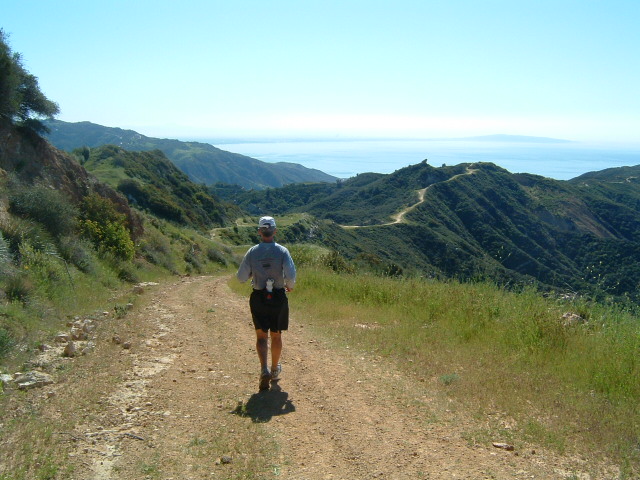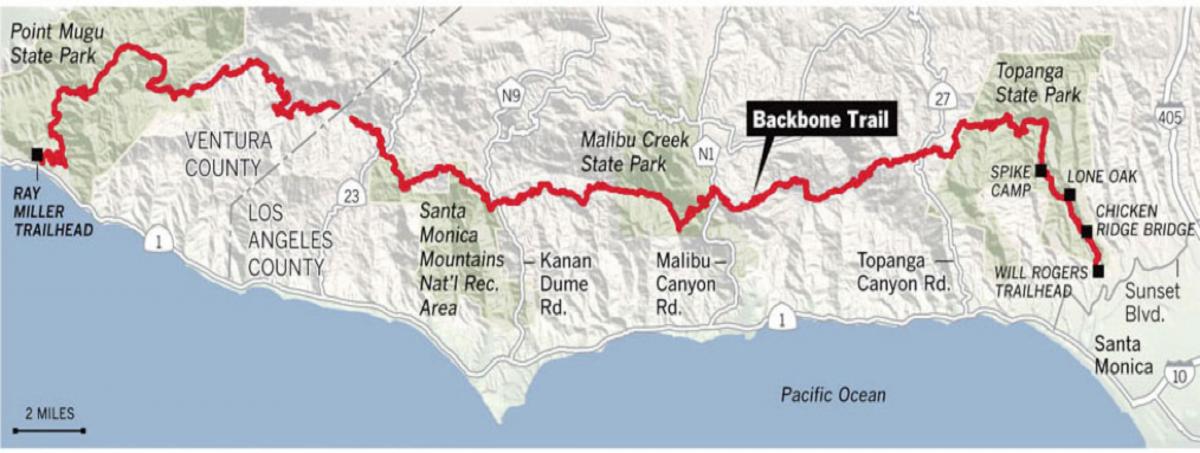It's finished! L.A.'s iconic Backbone Trail spans a glorious 67 miles
 |
| Take a walk on the wild side on the Backbone Trail in the Santa Monica Mountains, which spans 67 miles from West L.A. to Ventura County. Credit: Jim Wolff/Wikimedia Commons |
Any significant achievement is an expression of many individual accomplishments linked together by a mutual vision and common purpose. The opening of the Backbone Trail on June 4 marks the realization of a long-held goal to connect Will Rogers State Historic Park in Pacific Palisades to Point Mugu State Park in Ventura County through some of Southern California’s most beautiful ecology and scenic terrain.
The trail has been nominated for designation as a National Recreation Trail. If selected, the designation will be announced by the Secretary of the Interior on or before June 4, which coincides with National Trails Day.
The National Park Service will hold an official opening/dedication of the trail at 9 a.m. June 4 at Will Rogers State Park.
Sierra Club has lots of free Backbone Trail hikes open to all! Check it out at #Hikethe100 and experience your wild backyard.
Backbone Trail, mile by mile
The 67-mile Backbone Trail was created mile by mile by piecing together the hard work of trail-building, trail design funding, political support, and acquisition by the public of more than 180 parcels. During the course of more than 40 years, dedicated volunteers, elected officials, parks agencies, and generous philanthropists from many diverse backgrounds came together to make the dream of a trail traversing public lands in the Santa Monica Mountains a reality. When finished, the trail will form the spine of a 500-mile network of trails that connects the residents of Los Angeles and Ventura Counties to their public lands.
The Backbone Trail, originally known colloquially as the Devil’s Backbone Trail early in the 20th century, was later called the Proposed Ridge Trail in the early 1970s.
 |
| Get to know your wild backyard: You can walk segments of the Backbone Trail throughout the year on Sierra Club hikes. You'll find them listed on the online Schedule of Activities. Credit: National Park Service |
In 1974, the California Legislature approved the early version of and funding for the original trail with an easternmost trailhead located roughly west of Griffith Park. Development of properties around Griffith Park in the mid-1970s, however, precluded this section from being included and the trailhead was moved west to Will Rogers State Park instead, shrinking the total length of the trail by about 15 to 20 miles.
The Sierra Club leader who helped built it
As land was being obtained with state and federal funds, the need for trails in the Santa Monica Mountains was recognized. In the 1970s, a trail crew was organized, led by the Sierra Club’s master trail builder, Ron Webster. Over the years, this volunteer crew has built and maintained a great many of the trails in the Santa Monica Mountains.
Some of these trails laid the foundation for the Backbone Trail, including Musch Ranch, Topanga Nature, Dead Horse, Piuma Ridge, Saddle Creek, Fossil Ridge, Hondo Canyon, Ray Miller, Wood Canyon Vista, Coyote Trail, and many more. The Trail Crew maintains a strong program of building and maintaining trails that support recreational use throughout the Santa Monica Mountains and in adjacent parkland. Click here to find out how you can get involved.
| A high point in the Backbone Trail near Castro Crest. Credit: Mary Forgione/Sierra Club |
Trail development involves studying the topography to plot a route that takes advantage of scenic beauty, best serves public needs, avoids hazards and “lays lightly on the land.”
A small group of hikers is credited with walking the length of the proposed trail, beginning in 1983, to develop an alignment for the Backbone Trail that accomplishes these goals. Some segments of the Backbone Trail improved historic ranching trails dating back to the days of Mexican land grants. Other segments were newly blazed by trail crews, including Webster’s, composed of dedicated volunteers and State Parks workers.
Getting the trail just right
The path from map to field, however, often presents unexpected challenges in trail siting and construction.
Want to help maintain the Backbone Trail? Volunteers are always needed to help build and maintain trails in the Santa Monica Mountains. No experience required. Trail volunteers work 8:30 a.m. to 2 p.m. on Saturdays from October through June. Tools and instructions provided. For meeting time/place contact leaders Ron Webster at mawebster1984@sbcglobal.net or John Russell Marshall at russmarshall13@gmail.com.
As is required of any hiker undertaking a lengthy trek, supporters of the Backbone Trail exhibited perseverance and resilience in their resolve to complete the trail. The perennial quest to obtain funding became a community mission. Citizen and government organizations, including the Sierra Club, Santa Monica Mountains Trails Council, Santa Monica Mountains Conservancy, the National Park Service and California State Parks took up the cause to raise or contribute funding for the Backbone Trail.
State representatives were political champions who sponsored legislation to secure money for the trail. Federal funds obtained to acquire land that closed private-property gaps along the route and to improve trail-related facilities such as parking lots and restrooms were matched in part by Los Angeles County. Other challenges included avoiding Native American archaeological sites encountered along the route and weathering fire, flood and earthquake damage during trail construction.
Linking the 'scattered beauties' of the Santa Monica Mountains
| The Backbone Trail twists along the spine of the Santa Monica Mountains, giving inland views of the hills (above) as well as coastal vistas. Credit: Mary Forgione/Sierra Club |
As portrayed by hiking guide writer John McKinney in a 1990 Los Angeles Times article:
“The Backbone Trail passes through national, state and county parkland in addition to lands owned by the Santa Monica Mountains Conservancy. It’s a rich pastiche of nature walks, scenic viewpoints, fire roads and horse trails leading through diverse ecosystems: meadowlands, savannas, yucca-covered slopes, handsome sandstone formations and springs surrounded by lush ferns. When finished, the trail will literally and symbolically link the scattered beauties of the Santa Monica Mountains.”
For the early visionaries who explored the unimproved route, some of whom are not alive today to celebrate with us, the completion and opening of the Backbone Trail is their legacy.



Add new comment